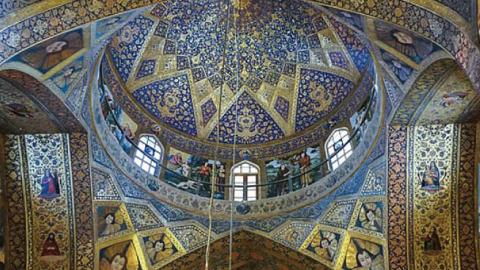On September 25, Article Eighteen, a website that advocates for the rights of Iranian Christians, published a disturbing interview with 66-year-old Pastor Victor Bet-Tamraz. He and his wife Shamiram have fled their lifelong homeland. A legal struggle, which began in late 2014 when authorities held the pastor in brutal solitary confinement for 65 days, culminated in 2017. The courts sentenced him to 10 years in prison for “actions against national security.” They sentenced his wife to five years. The government rejected their final appeals in August.
“I didn’t want to leave Iran at all,” Pastor Bet-Tamraz explained. “If they gave me two years, three years in prison, I would have endured it. But they issued the verdict very late, and I am almost 66 years old now. You can imagine, if I would go to prison now, I would go in alive, but most likely I wouldn’t come out alive. But leaving Iran was the hardest journey I’ve ever made.”
Bet-Tamraz knew all too well what future imprisonment would hold for him and his wife. He already endured great suffering. But having begun his ministry in 1975 as a pastor in a legally recognized denomination, he remains emotionally and spiritually rooted in the lives of his congregation. For him and his wife, leaving all that behind is a great tragedy.
This story comes as no surprise to those familiar with Iran’s human rights record. Notorious for its outrageous cruelties, the Islamic Republic of Iran remains one of the world’s worst persecutors of religious minorities. The US Commission on International Religious Freedom (USCIRF) recommended in its 2020 report that the United States should “Redesignate Iran as a ‘country of particular concern,’ or CPC, for engaging in systematic, ongoing, and egregious violations of religious freedom.”
At the same time, Open Doors’ 2020 World Watch List places Iran as the ninth-worst persecutor of Christians in the world. Bet-Tamraz’s experience is emblematic of the suffering Iranian Christians have endured since the 1979 Islamic Revolution.
Today, however, the Islamic Republic unleashes most of its vitriol on Christian converts from Islam, whom it views as apostates, and often designates them as “Christian Zionists.” Yet despite the dangers, many of these converts are young, zealous, and outspoken.
Mary Mohammnadi serves as an example. President Donald Trump mentioned her by name during a National Prayer Breakfast speech, noting that Iran imprisoned her because “she converted to Christianity and shared the Gospel with others.”
After her conversion, the regime sentenced Mary to six months in prison in late 2017 for her Christian activities, which it characterized as “action against national security” and “propaganda against the system.” In 2019 Tehran University kicked Mary out without explanation on the eve of her English-language exams. A few weeks later, on January 12, authorities arrested her as protests took place in Azadi Square.
After that arrest, Mary is said to have been beaten so badly that her bruises were evident for weeks. She was mistreated in Iran’s Evin Prison, and the government held her in Iran’s infamous Qarchak women’s detention center, a filthy facility where she suffered further abused.
On February 28, 2020, the regime released Mary on bail, prior to her final sentencing, which took place last April. At that time she received a suspended sentence of three months and one day and 10 lashes. Yet today, despite the risks, she perseveres. Mary serves as one example of valiant young Christian converts from Islam who take enormous risks for practicing and sharing their faith
Meanwhile, those conversions are unfolding across Iran against a backdrop of apostasy. Atheism is surging. There are numerous anecdotal reports of mosques that sit nearly empty in major Iranian cities, and that religious practices are rapidly diminishing. The more Iranians turn their backs on the brand of Shiite Islam that rules the country with an iron fist, the more dangerous and potentially deadly Christian conversion becomes.
But how widespread are the conversions? Since new Christian believers don’t appear in any official surveys or censuses, many—largely uneasy Christian groups—have disputed their numbers for years. Stories persist on social media and in other forums about large house church movements comprised of new believers; they are nearly impossible to verify.
But in early September a rather startling headline appeared in Christianity Today: “Researchers Find Christians in Iran Approaching 1 Million.” An intriguing subhead followed: “Secular survey may succeed where Christian advocates have failed to convince the world of widespread conversions in the Islamic republic.”
The story continues, “Extrapolating over Iran’s population of approximately 50 million literate adults (the sample surveyed) yields at least 750,000 believers… the number of Christians in Iran is without doubt in the order of magnitude of several hundreds of thousands and growing beyond a million.” This contrasts dramatically with the traditional (and legally recognized) Armenian and Assyrian Christians in Iran. They number just over 100,000, according to the latest government statistics.
Iran is a religious dictatorship, and a cruel one. At its core is an apocalyptic cult, preparing for the emergence of a Shiite messianic figure, the Imam Mahdi. Those preparations involve not only persecution of other faiths, but attacks on individuals, states, and movements that stand in the way of what the regime calls “exporting the Revolution.” The dangers of such a belief system are self-evident, and the trail of blood is well-documented.
Yes, despite that perilous bulwark, the bold and brave witness of untold numbers of new Christians is beginning to illuminate the Middle East and beyond. These converts embody the zeal of New Testament believers. And their light shines brightly in the shadows of today’s increasingly troubled world.
Read in Providence Magazine















